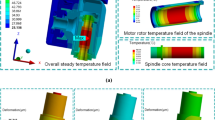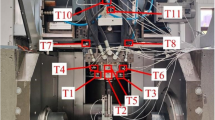Abstract
Thermal deformation is the main factor of the machining accuracy for grinding machines, which seriously restricts the precision improvement of grinding machines. However, at present, there are little researches on thermal error prediction, and the accuracy of the prediction model is comparatively low. Thus, a novel approach for thermal deformation prediction of grinding machine spindle based on heat energy conduction principle and neural network is proposed in this paper. Firstly, the temperature sensors’ pairs are applied to measure the temperature deviation between the spindle surface and its adjacent ambient which are directly related to the heat energy exchange. Secondly, the temperature deviations of each segment of the spindle are taken as inputs, which will exist and accumulate in the form of heat energy subsequently in the convolutional neural network. Meanwhile, the accumulated heat energy is mixed and transferred to the different segments of the spindle in the convolutional neural network. Thirdly, the thermal deformation caused by the increment of heat energy is considered as the output of thermal error prediction result based on the principle of heat energy conduction. Finally, the simulations and experiments are implemented to validate the feasibility and effectiveness of the proposed method.












Similar content being viewed by others
Data Availability
The authors confirm that the data supporting the findings of this study are available within the article.
References
Shen H, Fu J, He Y, Yao X (2012) On-line asynchronous compensation methods forstatic/quasi-static error implemented on CNC machine tools. Int J Mach Tools Manuf 60:14–26
Fu GQ, Fu JZ, Xu YT, Chen ZC, Lai JT (2015) Accuracy enhancement of five-axis machine tool based on differential motion matrix: geometric error modeling, identification and compensation. Int J Mach Tools Manuf 89:170–181
Xu ZZ, Liu XJ (2011) Thermal error prediction and performance evaluation for an air-cooling ball screw system. Int J Mach Tools Manuf 51:605–611
Li ZH, Fan KG (2014) Time-varying positioning error modeling and compensation for ball screw systems based on simulation and experimental analysis. Int J Adv Manuf Technol 73:773–782
Yun WS, Kim SK, Cho DW (1999) Thermal error analysis for a CNC lathe feed drive system. Int J Mach Tools Manuf 39:1087–1101
Mian NS, Fletcher S, Longstaff AP, Myers A (2013) Efficient estimation by FEA of machine tool distortion due to environmental temperature perturbations. Precis Eng 37:372–379
Bossmanns B, Tu JF (1999) A thermal model for high speed motorized spindles. Int J Mach Tools Manuf 39:1345–1366
Ali M. Abdulshahed et al (2016) Thermal error modelling of a gantry-type 5-axis machine tool using a Grey neural network model. J Manuf Syst 41:130–142
Chen J, Yuan J, Ni J (1996) Thermal error modelling for real-time error compensation. Int J Adv Manuf Technol 12:266–275
Chen J et al (1995) Quick testing and modeling of thermally-induced errors of CNC machine tools. Int J Mach Tools Manuf 35:1063–1074
Lee J-H, Lee J-H, Yang S-H (2001) Development of thermal error model with minimum number of variables using fuzzy logic strategy. KSME Int J 15:1482–1489
Abdulshahed A, Long staff AP, Fletcher S, Myers A. Comparative study of ANN and ANFIS prediction models for thermal error compensation on CNC machine tools. In: Laser metrology and machine performance X. 2013. p. 79–88
Wang KC (2006) Thermal error modeling of a machining center using Grey system theory and adaptive network-based fuzzy inference system. Cybernetics and intelligent systems, In p. 1–6
Wang Y, Zhang G, Moon KS, Sutherland JW (1998) Compensation for the thermal error of a multi-axis machining center. J Mater Process Technol 75:45–53
Wang KC. Thermal error modeling of a machining center using Grey system theory and HGA-trained neural network. In: Cybernetics and intelligent systems.2006. p. 1–7
Abdulshahed AM, Longstaff AP, S. (2015) Fletcher, The application of ANFIS prediction models for thermal error compensation on CNC machine tools. Appl Soft Comput 27:158–168
Mayr J, Müller M, Weikert S (2016) Automated thermal main spindle & B-axis error compensation of 5-axis machine tools. CIRP Ann - Manuf Technol 65(1):479–482
Ramesh R, Mannan MA, Poo AN et al (2003) Thermal error measurement and modelling in machine tools. Part II. Hybrid Bayesian Network-support vector machine model. Int J Mach Tools Manuf 43(4):405–419
Eskandari S, Arezoo B, Abdullah A (2013) Positional, geometrical, and thermal errors compensation by tool path modification using three methods of regression, neural networks, and fuzzy logic. Int J Adv Manuf Technol 65:1635–1649
Abdulshahed A, Longstaff AP, Fletcher S, Myers A. Application of GNNMCI (1, N) to environmental thermal error modelling of CNC machine tools. In: The 3rdinternational conference on advanced manufacturing engineering and technologies. 2013. p. 253–62
Abdulshahed AM, Longstaff AP, Fletcher S, Myers A (2015) Thermal error modelling of machine tools based on ANFIS with fuzzy c-means clustering using a thermal imaging camera. Appl Math Model 39:1837–1852
Abdulshahed A, Longstaff AP, Fletcher S. A particle swarm optimisation-based Grey prediction model for thermal error compensation on CNC machine tools. In: Laser metrology and machine performance XI, LAMDAMAP 2015. 2015. p.369–78
White A, Postlethwaite S, Ford DG (2001) A general purpose thermal error compensation system for CNC machine tools. Laser metrology and machine performance V, In p. 3–13
Code availability
The authors confirm that the codes supporting the findings of this study are available within the article.
Funding
This work is financially supported by the National Natural Science Foundation of China (grant no. 51775010 and 51705011), the National Science and Technology Major Project of China (grant no. 2019ZX040 060 01).
Author information
Authors and Affiliations
Contributions
Fan Jinwei and Wang Peitong provided ideas for this study and wrote codes and manuscripts. Haohao Tao and Ri Pan were responsible for the experiment in this study. All authors contributed to this study.
Corresponding author
Ethics declarations
Ethics approval
My research does not involve ethical issues.
Consent for publication
All the authors agreed to publish this paper.
Competing interests
The authors declare no competing interests.
Additional information
Publisher’s note
Springer Nature remains neutral with regard to jurisdictional claims in published maps and institutional affiliations.
Rights and permissions
About this article
Cite this article
Fan, J., Wang, P., Tao, H. et al. A thermal deformation prediction method for grinding machine’ spindle. Int J Adv Manuf Technol 118, 1125–1139 (2022). https://doi.org/10.1007/s00170-021-07931-5
Received:
Accepted:
Published:
Issue Date:
DOI: https://doi.org/10.1007/s00170-021-07931-5




